Bullying in nursing Assignment PDF
VerifiedAdded on 2021/06/17
|12
|3077
|21
AI Summary
Contribute Materials
Your contribution can guide someone’s learning journey. Share your
documents today.

Running head: BULLYING IN NURSING
BULLYING IN NURSING
Name of the student:
Name of the university:
Author note:
BULLYING IN NURSING
Name of the student:
Name of the university:
Author note:
Secure Best Marks with AI Grader
Need help grading? Try our AI Grader for instant feedback on your assignments.
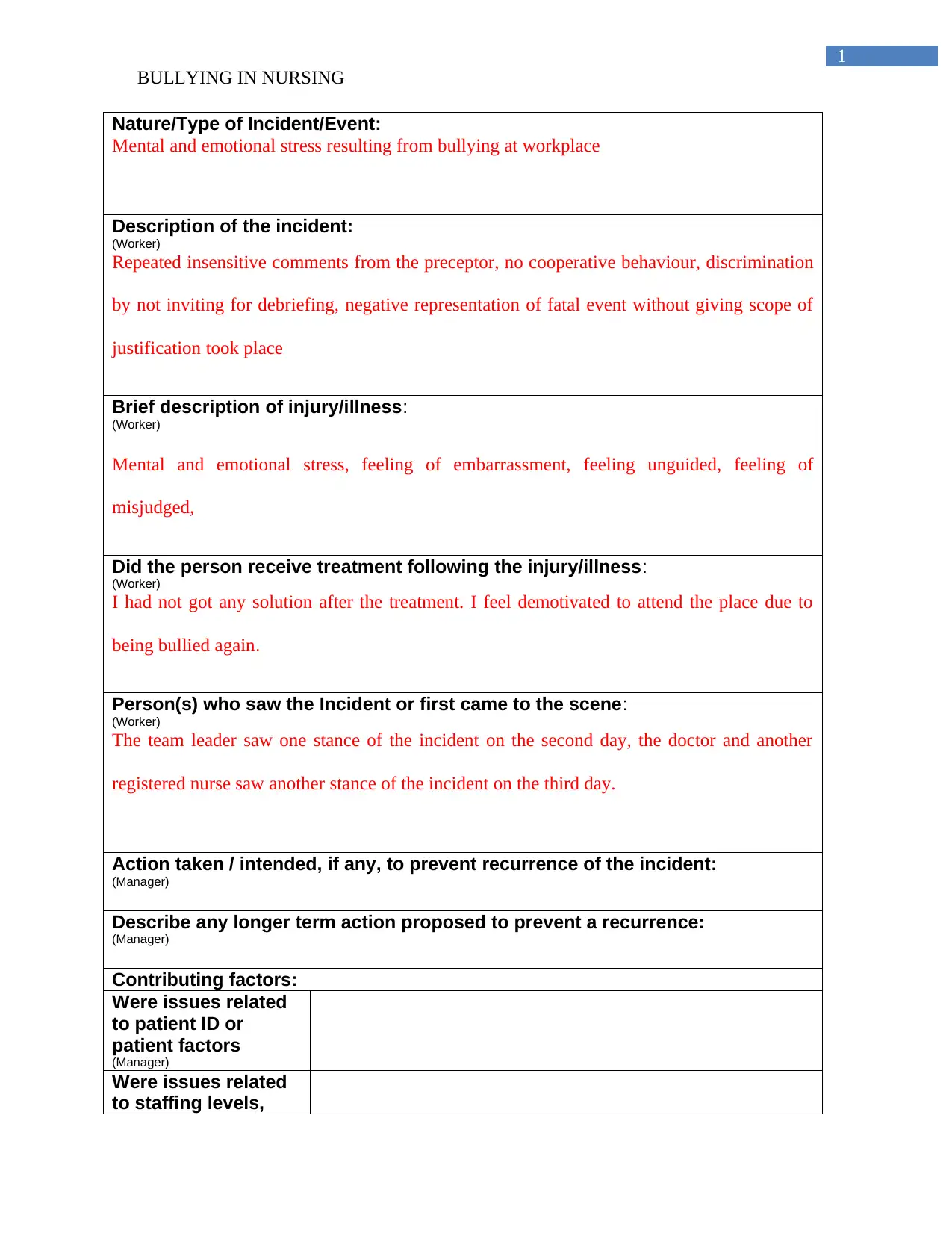
1
BULLYING IN NURSING
Nature/Type of Incident/Event:
Mental and emotional stress resulting from bullying at workplace
Description of the incident:
(Worker)
Repeated insensitive comments from the preceptor, no cooperative behaviour, discrimination
by not inviting for debriefing, negative representation of fatal event without giving scope of
justification took place
Brief description of injury/illness:
(Worker)
Mental and emotional stress, feeling of embarrassment, feeling unguided, feeling of
misjudged,
Did the person receive treatment following the injury/illness:
(Worker)
I had not got any solution after the treatment. I feel demotivated to attend the place due to
being bullied again.
Person(s) who saw the Incident or first came to the scene:
(Worker)
The team leader saw one stance of the incident on the second day, the doctor and another
registered nurse saw another stance of the incident on the third day.
Action taken / intended, if any, to prevent recurrence of the incident:
(Manager)
Describe any longer term action proposed to prevent a recurrence:
(Manager)
Contributing factors:
Were issues related
to patient ID or
patient factors
(Manager)
Were issues related
to staffing levels,
BULLYING IN NURSING
Nature/Type of Incident/Event:
Mental and emotional stress resulting from bullying at workplace
Description of the incident:
(Worker)
Repeated insensitive comments from the preceptor, no cooperative behaviour, discrimination
by not inviting for debriefing, negative representation of fatal event without giving scope of
justification took place
Brief description of injury/illness:
(Worker)
Mental and emotional stress, feeling of embarrassment, feeling unguided, feeling of
misjudged,
Did the person receive treatment following the injury/illness:
(Worker)
I had not got any solution after the treatment. I feel demotivated to attend the place due to
being bullied again.
Person(s) who saw the Incident or first came to the scene:
(Worker)
The team leader saw one stance of the incident on the second day, the doctor and another
registered nurse saw another stance of the incident on the third day.
Action taken / intended, if any, to prevent recurrence of the incident:
(Manager)
Describe any longer term action proposed to prevent a recurrence:
(Manager)
Contributing factors:
Were issues related
to patient ID or
patient factors
(Manager)
Were issues related
to staffing levels,
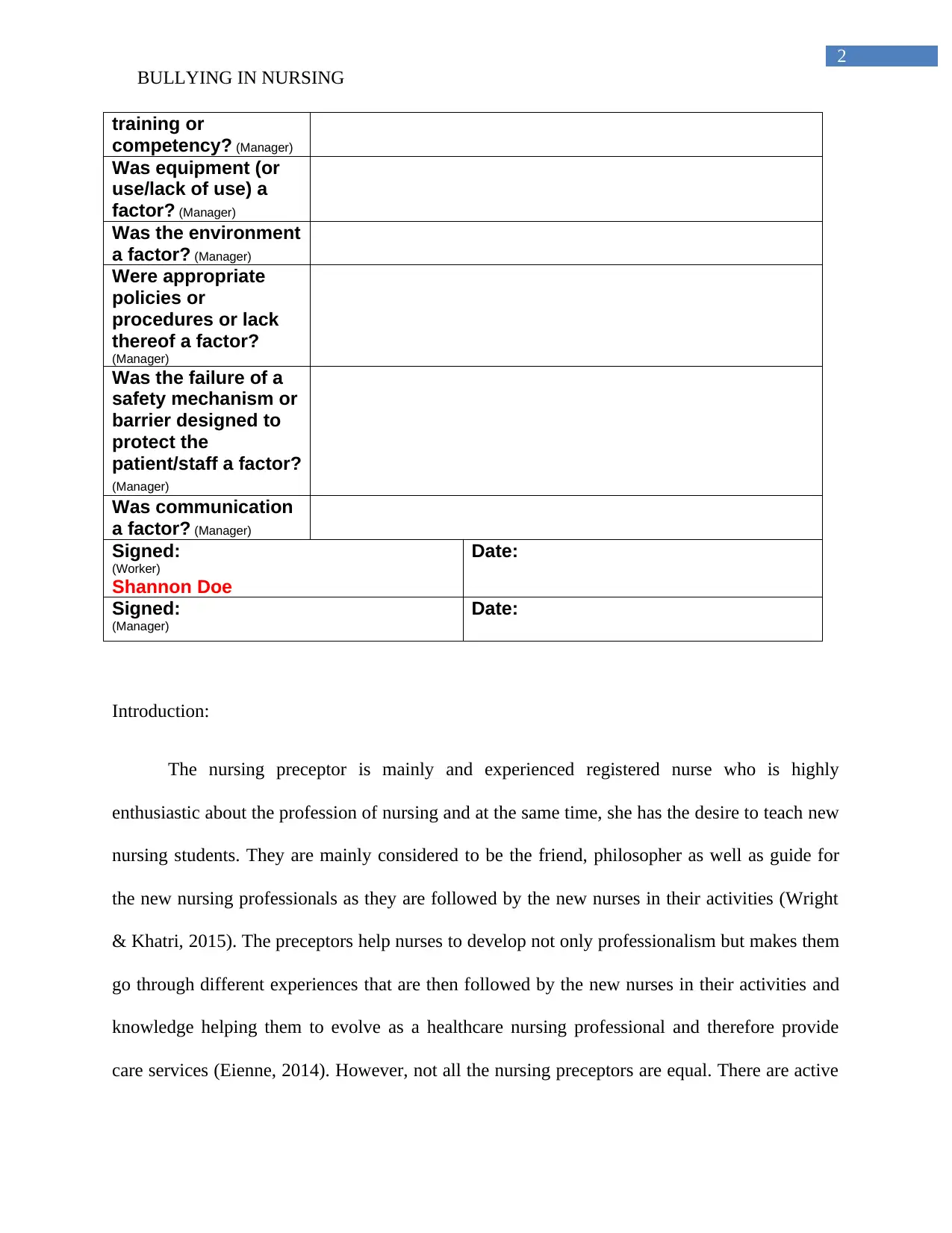
2
BULLYING IN NURSING
training or
competency? (Manager)
Was equipment (or
use/lack of use) a
factor? (Manager)
Was the environment
a factor? (Manager)
Were appropriate
policies or
procedures or lack
thereof a factor?
(Manager)
Was the failure of a
safety mechanism or
barrier designed to
protect the
patient/staff a factor?
(Manager)
Was communication
a factor? (Manager)
Signed:
(Worker)
Shannon Doe
Date:
Signed:
(Manager)
Date:
Introduction:
The nursing preceptor is mainly and experienced registered nurse who is highly
enthusiastic about the profession of nursing and at the same time, she has the desire to teach new
nursing students. They are mainly considered to be the friend, philosopher as well as guide for
the new nursing professionals as they are followed by the new nurses in their activities (Wright
& Khatri, 2015). The preceptors help nurses to develop not only professionalism but makes them
go through different experiences that are then followed by the new nurses in their activities and
knowledge helping them to evolve as a healthcare nursing professional and therefore provide
care services (Eienne, 2014). However, not all the nursing preceptors are equal. There are active
BULLYING IN NURSING
training or
competency? (Manager)
Was equipment (or
use/lack of use) a
factor? (Manager)
Was the environment
a factor? (Manager)
Were appropriate
policies or
procedures or lack
thereof a factor?
(Manager)
Was the failure of a
safety mechanism or
barrier designed to
protect the
patient/staff a factor?
(Manager)
Was communication
a factor? (Manager)
Signed:
(Worker)
Shannon Doe
Date:
Signed:
(Manager)
Date:
Introduction:
The nursing preceptor is mainly and experienced registered nurse who is highly
enthusiastic about the profession of nursing and at the same time, she has the desire to teach new
nursing students. They are mainly considered to be the friend, philosopher as well as guide for
the new nursing professionals as they are followed by the new nurses in their activities (Wright
& Khatri, 2015). The preceptors help nurses to develop not only professionalism but makes them
go through different experiences that are then followed by the new nurses in their activities and
knowledge helping them to evolve as a healthcare nursing professional and therefore provide
care services (Eienne, 2014). However, not all the nursing preceptors are equal. There are active
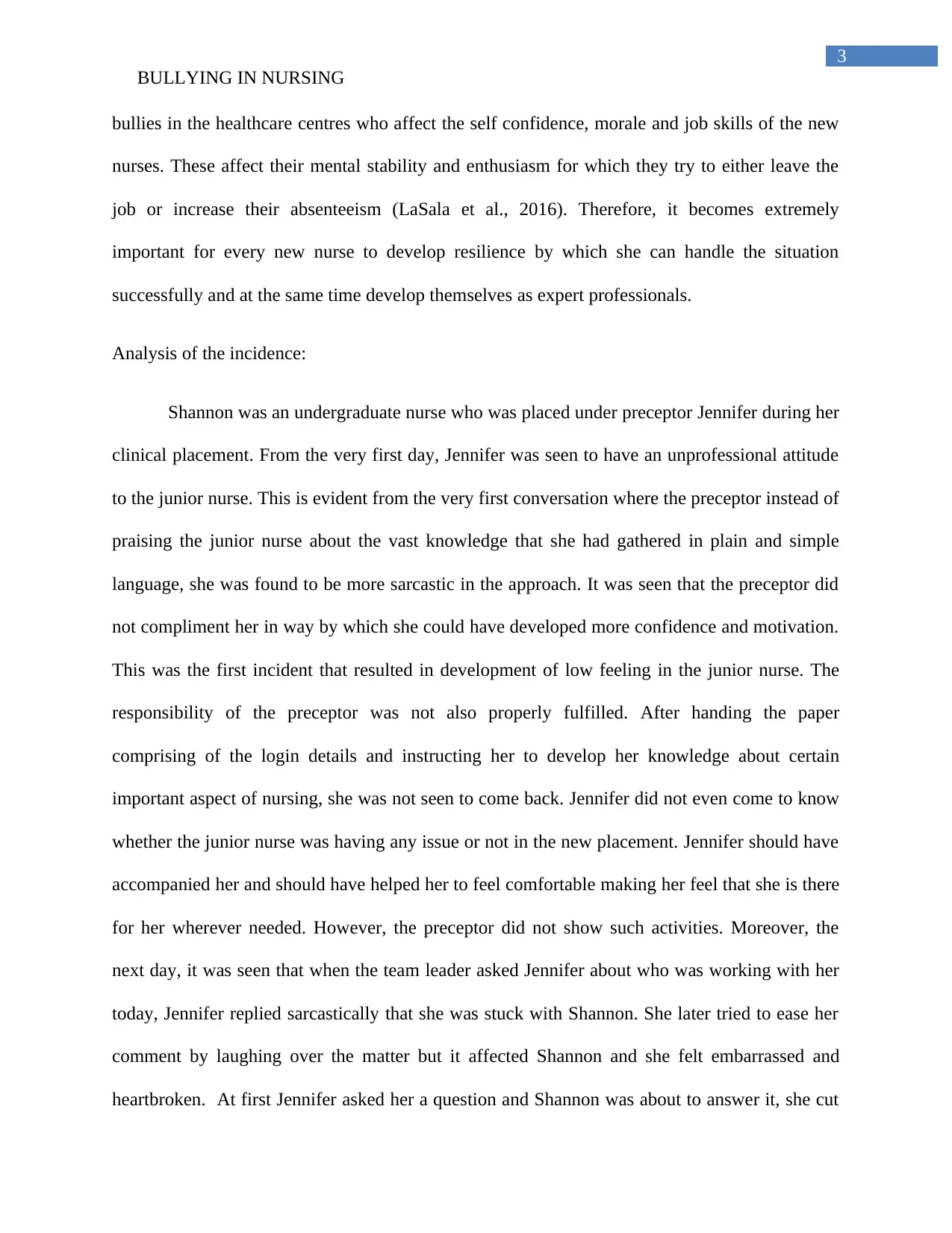
3
BULLYING IN NURSING
bullies in the healthcare centres who affect the self confidence, morale and job skills of the new
nurses. These affect their mental stability and enthusiasm for which they try to either leave the
job or increase their absenteeism (LaSala et al., 2016). Therefore, it becomes extremely
important for every new nurse to develop resilience by which she can handle the situation
successfully and at the same time develop themselves as expert professionals.
Analysis of the incidence:
Shannon was an undergraduate nurse who was placed under preceptor Jennifer during her
clinical placement. From the very first day, Jennifer was seen to have an unprofessional attitude
to the junior nurse. This is evident from the very first conversation where the preceptor instead of
praising the junior nurse about the vast knowledge that she had gathered in plain and simple
language, she was found to be more sarcastic in the approach. It was seen that the preceptor did
not compliment her in way by which she could have developed more confidence and motivation.
This was the first incident that resulted in development of low feeling in the junior nurse. The
responsibility of the preceptor was not also properly fulfilled. After handing the paper
comprising of the login details and instructing her to develop her knowledge about certain
important aspect of nursing, she was not seen to come back. Jennifer did not even come to know
whether the junior nurse was having any issue or not in the new placement. Jennifer should have
accompanied her and should have helped her to feel comfortable making her feel that she is there
for her wherever needed. However, the preceptor did not show such activities. Moreover, the
next day, it was seen that when the team leader asked Jennifer about who was working with her
today, Jennifer replied sarcastically that she was stuck with Shannon. She later tried to ease her
comment by laughing over the matter but it affected Shannon and she felt embarrassed and
heartbroken. At first Jennifer asked her a question and Shannon was about to answer it, she cut
BULLYING IN NURSING
bullies in the healthcare centres who affect the self confidence, morale and job skills of the new
nurses. These affect their mental stability and enthusiasm for which they try to either leave the
job or increase their absenteeism (LaSala et al., 2016). Therefore, it becomes extremely
important for every new nurse to develop resilience by which she can handle the situation
successfully and at the same time develop themselves as expert professionals.
Analysis of the incidence:
Shannon was an undergraduate nurse who was placed under preceptor Jennifer during her
clinical placement. From the very first day, Jennifer was seen to have an unprofessional attitude
to the junior nurse. This is evident from the very first conversation where the preceptor instead of
praising the junior nurse about the vast knowledge that she had gathered in plain and simple
language, she was found to be more sarcastic in the approach. It was seen that the preceptor did
not compliment her in way by which she could have developed more confidence and motivation.
This was the first incident that resulted in development of low feeling in the junior nurse. The
responsibility of the preceptor was not also properly fulfilled. After handing the paper
comprising of the login details and instructing her to develop her knowledge about certain
important aspect of nursing, she was not seen to come back. Jennifer did not even come to know
whether the junior nurse was having any issue or not in the new placement. Jennifer should have
accompanied her and should have helped her to feel comfortable making her feel that she is there
for her wherever needed. However, the preceptor did not show such activities. Moreover, the
next day, it was seen that when the team leader asked Jennifer about who was working with her
today, Jennifer replied sarcastically that she was stuck with Shannon. She later tried to ease her
comment by laughing over the matter but it affected Shannon and she felt embarrassed and
heartbroken. At first Jennifer asked her a question and Shannon was about to answer it, she cut
Secure Best Marks with AI Grader
Need help grading? Try our AI Grader for instant feedback on your assignments.
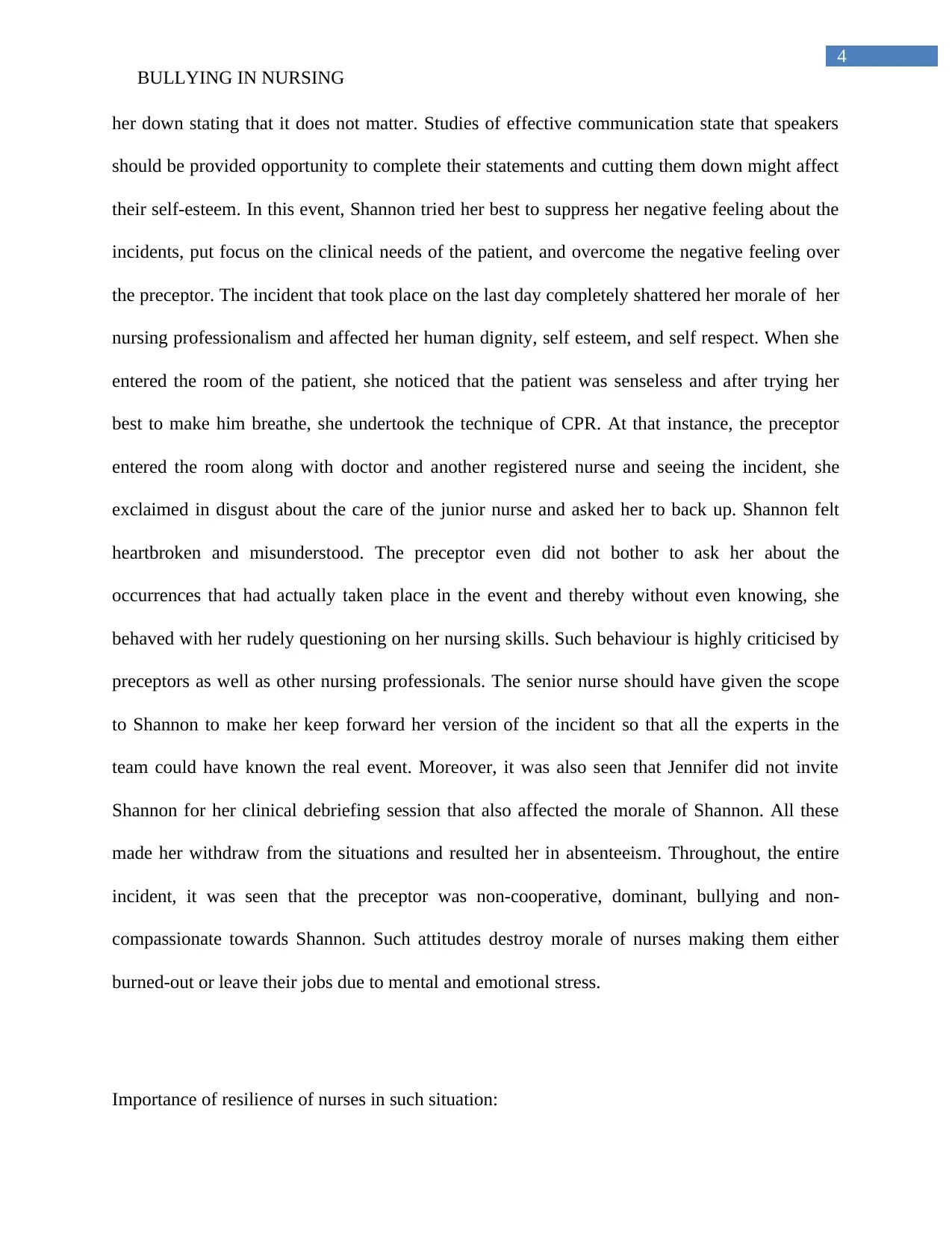
4
BULLYING IN NURSING
her down stating that it does not matter. Studies of effective communication state that speakers
should be provided opportunity to complete their statements and cutting them down might affect
their self-esteem. In this event, Shannon tried her best to suppress her negative feeling about the
incidents, put focus on the clinical needs of the patient, and overcome the negative feeling over
the preceptor. The incident that took place on the last day completely shattered her morale of her
nursing professionalism and affected her human dignity, self esteem, and self respect. When she
entered the room of the patient, she noticed that the patient was senseless and after trying her
best to make him breathe, she undertook the technique of CPR. At that instance, the preceptor
entered the room along with doctor and another registered nurse and seeing the incident, she
exclaimed in disgust about the care of the junior nurse and asked her to back up. Shannon felt
heartbroken and misunderstood. The preceptor even did not bother to ask her about the
occurrences that had actually taken place in the event and thereby without even knowing, she
behaved with her rudely questioning on her nursing skills. Such behaviour is highly criticised by
preceptors as well as other nursing professionals. The senior nurse should have given the scope
to Shannon to make her keep forward her version of the incident so that all the experts in the
team could have known the real event. Moreover, it was also seen that Jennifer did not invite
Shannon for her clinical debriefing session that also affected the morale of Shannon. All these
made her withdraw from the situations and resulted her in absenteeism. Throughout, the entire
incident, it was seen that the preceptor was non-cooperative, dominant, bullying and non-
compassionate towards Shannon. Such attitudes destroy morale of nurses making them either
burned-out or leave their jobs due to mental and emotional stress.
Importance of resilience of nurses in such situation:
BULLYING IN NURSING
her down stating that it does not matter. Studies of effective communication state that speakers
should be provided opportunity to complete their statements and cutting them down might affect
their self-esteem. In this event, Shannon tried her best to suppress her negative feeling about the
incidents, put focus on the clinical needs of the patient, and overcome the negative feeling over
the preceptor. The incident that took place on the last day completely shattered her morale of her
nursing professionalism and affected her human dignity, self esteem, and self respect. When she
entered the room of the patient, she noticed that the patient was senseless and after trying her
best to make him breathe, she undertook the technique of CPR. At that instance, the preceptor
entered the room along with doctor and another registered nurse and seeing the incident, she
exclaimed in disgust about the care of the junior nurse and asked her to back up. Shannon felt
heartbroken and misunderstood. The preceptor even did not bother to ask her about the
occurrences that had actually taken place in the event and thereby without even knowing, she
behaved with her rudely questioning on her nursing skills. Such behaviour is highly criticised by
preceptors as well as other nursing professionals. The senior nurse should have given the scope
to Shannon to make her keep forward her version of the incident so that all the experts in the
team could have known the real event. Moreover, it was also seen that Jennifer did not invite
Shannon for her clinical debriefing session that also affected the morale of Shannon. All these
made her withdraw from the situations and resulted her in absenteeism. Throughout, the entire
incident, it was seen that the preceptor was non-cooperative, dominant, bullying and non-
compassionate towards Shannon. Such attitudes destroy morale of nurses making them either
burned-out or leave their jobs due to mental and emotional stress.
Importance of resilience of nurses in such situation:
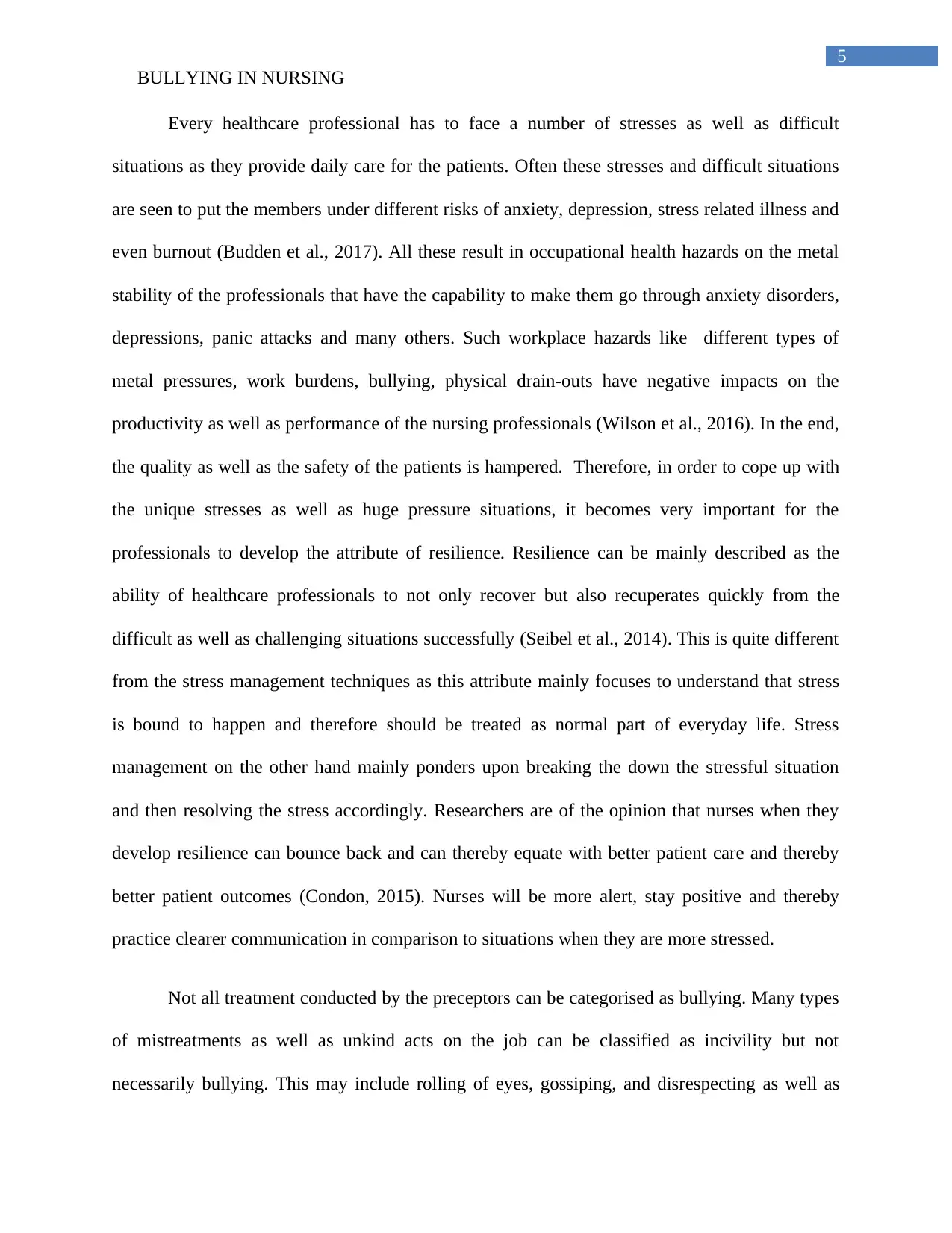
5
BULLYING IN NURSING
Every healthcare professional has to face a number of stresses as well as difficult
situations as they provide daily care for the patients. Often these stresses and difficult situations
are seen to put the members under different risks of anxiety, depression, stress related illness and
even burnout (Budden et al., 2017). All these result in occupational health hazards on the metal
stability of the professionals that have the capability to make them go through anxiety disorders,
depressions, panic attacks and many others. Such workplace hazards like different types of
metal pressures, work burdens, bullying, physical drain-outs have negative impacts on the
productivity as well as performance of the nursing professionals (Wilson et al., 2016). In the end,
the quality as well as the safety of the patients is hampered. Therefore, in order to cope up with
the unique stresses as well as huge pressure situations, it becomes very important for the
professionals to develop the attribute of resilience. Resilience can be mainly described as the
ability of healthcare professionals to not only recover but also recuperates quickly from the
difficult as well as challenging situations successfully (Seibel et al., 2014). This is quite different
from the stress management techniques as this attribute mainly focuses to understand that stress
is bound to happen and therefore should be treated as normal part of everyday life. Stress
management on the other hand mainly ponders upon breaking the down the stressful situation
and then resolving the stress accordingly. Researchers are of the opinion that nurses when they
develop resilience can bounce back and can thereby equate with better patient care and thereby
better patient outcomes (Condon, 2015). Nurses will be more alert, stay positive and thereby
practice clearer communication in comparison to situations when they are more stressed.
Not all treatment conducted by the preceptors can be categorised as bullying. Many types
of mistreatments as well as unkind acts on the job can be classified as incivility but not
necessarily bullying. This may include rolling of eyes, gossiping, and disrespecting as well as
BULLYING IN NURSING
Every healthcare professional has to face a number of stresses as well as difficult
situations as they provide daily care for the patients. Often these stresses and difficult situations
are seen to put the members under different risks of anxiety, depression, stress related illness and
even burnout (Budden et al., 2017). All these result in occupational health hazards on the metal
stability of the professionals that have the capability to make them go through anxiety disorders,
depressions, panic attacks and many others. Such workplace hazards like different types of
metal pressures, work burdens, bullying, physical drain-outs have negative impacts on the
productivity as well as performance of the nursing professionals (Wilson et al., 2016). In the end,
the quality as well as the safety of the patients is hampered. Therefore, in order to cope up with
the unique stresses as well as huge pressure situations, it becomes very important for the
professionals to develop the attribute of resilience. Resilience can be mainly described as the
ability of healthcare professionals to not only recover but also recuperates quickly from the
difficult as well as challenging situations successfully (Seibel et al., 2014). This is quite different
from the stress management techniques as this attribute mainly focuses to understand that stress
is bound to happen and therefore should be treated as normal part of everyday life. Stress
management on the other hand mainly ponders upon breaking the down the stressful situation
and then resolving the stress accordingly. Researchers are of the opinion that nurses when they
develop resilience can bounce back and can thereby equate with better patient care and thereby
better patient outcomes (Condon, 2015). Nurses will be more alert, stay positive and thereby
practice clearer communication in comparison to situations when they are more stressed.
Not all treatment conducted by the preceptors can be categorised as bullying. Many types
of mistreatments as well as unkind acts on the job can be classified as incivility but not
necessarily bullying. This may include rolling of eyes, gossiping, and disrespecting as well as
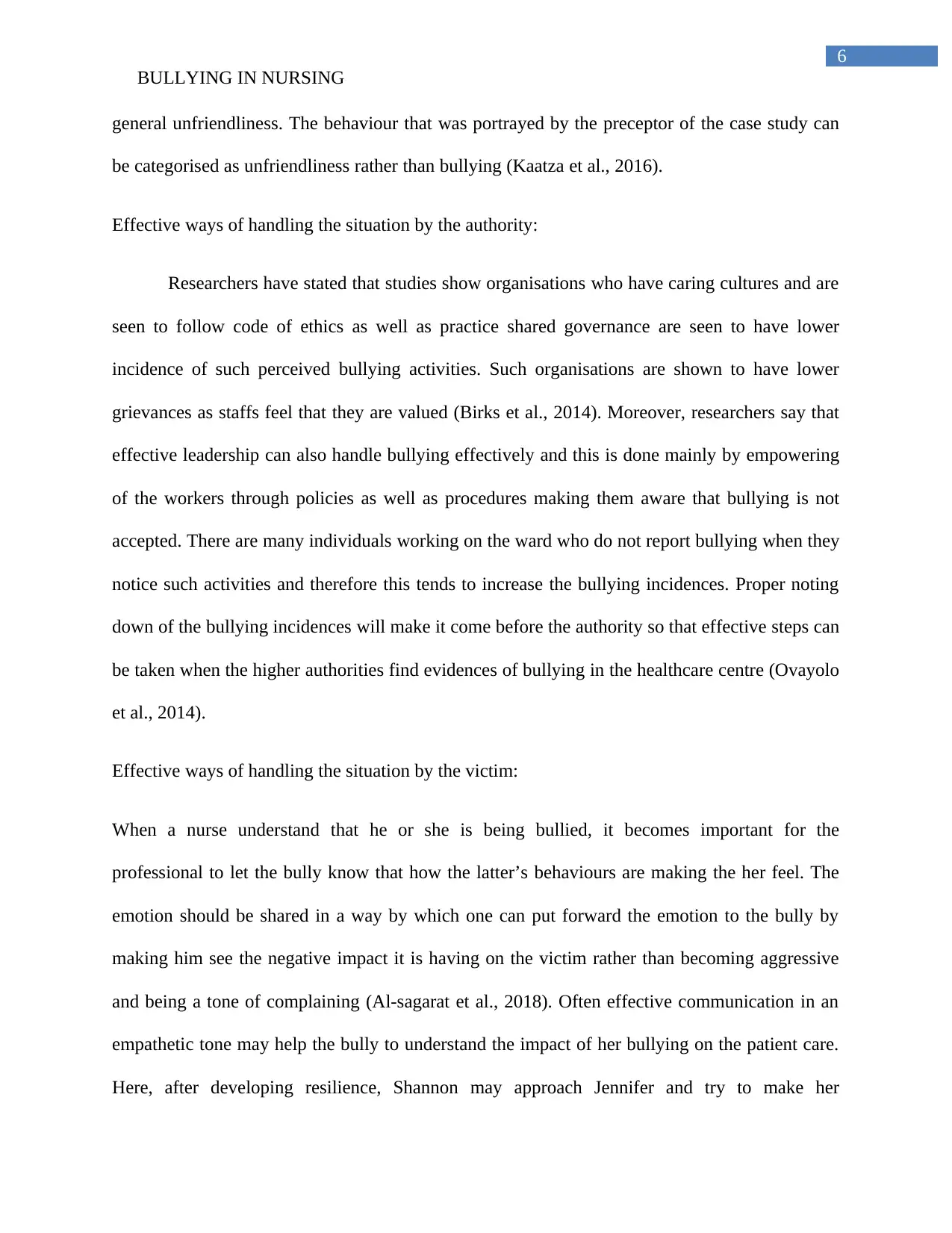
6
BULLYING IN NURSING
general unfriendliness. The behaviour that was portrayed by the preceptor of the case study can
be categorised as unfriendliness rather than bullying (Kaatza et al., 2016).
Effective ways of handling the situation by the authority:
Researchers have stated that studies show organisations who have caring cultures and are
seen to follow code of ethics as well as practice shared governance are seen to have lower
incidence of such perceived bullying activities. Such organisations are shown to have lower
grievances as staffs feel that they are valued (Birks et al., 2014). Moreover, researchers say that
effective leadership can also handle bullying effectively and this is done mainly by empowering
of the workers through policies as well as procedures making them aware that bullying is not
accepted. There are many individuals working on the ward who do not report bullying when they
notice such activities and therefore this tends to increase the bullying incidences. Proper noting
down of the bullying incidences will make it come before the authority so that effective steps can
be taken when the higher authorities find evidences of bullying in the healthcare centre (Ovayolo
et al., 2014).
Effective ways of handling the situation by the victim:
When a nurse understand that he or she is being bullied, it becomes important for the
professional to let the bully know that how the latter’s behaviours are making the her feel. The
emotion should be shared in a way by which one can put forward the emotion to the bully by
making him see the negative impact it is having on the victim rather than becoming aggressive
and being a tone of complaining (Al-sagarat et al., 2018). Often effective communication in an
empathetic tone may help the bully to understand the impact of her bullying on the patient care.
Here, after developing resilience, Shannon may approach Jennifer and try to make her
BULLYING IN NURSING
general unfriendliness. The behaviour that was portrayed by the preceptor of the case study can
be categorised as unfriendliness rather than bullying (Kaatza et al., 2016).
Effective ways of handling the situation by the authority:
Researchers have stated that studies show organisations who have caring cultures and are
seen to follow code of ethics as well as practice shared governance are seen to have lower
incidence of such perceived bullying activities. Such organisations are shown to have lower
grievances as staffs feel that they are valued (Birks et al., 2014). Moreover, researchers say that
effective leadership can also handle bullying effectively and this is done mainly by empowering
of the workers through policies as well as procedures making them aware that bullying is not
accepted. There are many individuals working on the ward who do not report bullying when they
notice such activities and therefore this tends to increase the bullying incidences. Proper noting
down of the bullying incidences will make it come before the authority so that effective steps can
be taken when the higher authorities find evidences of bullying in the healthcare centre (Ovayolo
et al., 2014).
Effective ways of handling the situation by the victim:
When a nurse understand that he or she is being bullied, it becomes important for the
professional to let the bully know that how the latter’s behaviours are making the her feel. The
emotion should be shared in a way by which one can put forward the emotion to the bully by
making him see the negative impact it is having on the victim rather than becoming aggressive
and being a tone of complaining (Al-sagarat et al., 2018). Often effective communication in an
empathetic tone may help the bully to understand the impact of her bullying on the patient care.
Here, after developing resilience, Shannon may approach Jennifer and try to make her
Paraphrase This Document
Need a fresh take? Get an instant paraphrase of this document with our AI Paraphraser
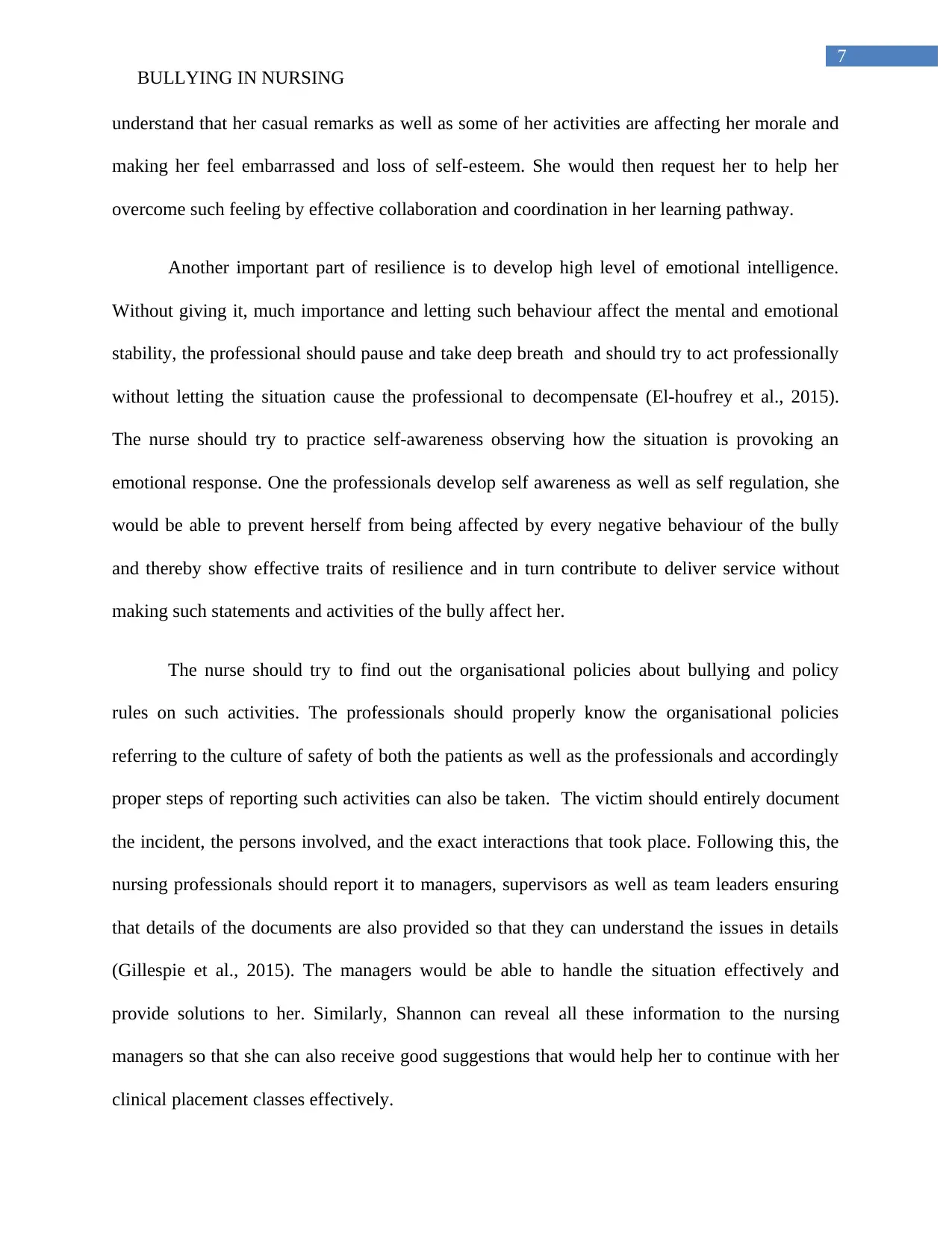
7
BULLYING IN NURSING
understand that her casual remarks as well as some of her activities are affecting her morale and
making her feel embarrassed and loss of self-esteem. She would then request her to help her
overcome such feeling by effective collaboration and coordination in her learning pathway.
Another important part of resilience is to develop high level of emotional intelligence.
Without giving it, much importance and letting such behaviour affect the mental and emotional
stability, the professional should pause and take deep breath and should try to act professionally
without letting the situation cause the professional to decompensate (El-houfrey et al., 2015).
The nurse should try to practice self-awareness observing how the situation is provoking an
emotional response. One the professionals develop self awareness as well as self regulation, she
would be able to prevent herself from being affected by every negative behaviour of the bully
and thereby show effective traits of resilience and in turn contribute to deliver service without
making such statements and activities of the bully affect her.
The nurse should try to find out the organisational policies about bullying and policy
rules on such activities. The professionals should properly know the organisational policies
referring to the culture of safety of both the patients as well as the professionals and accordingly
proper steps of reporting such activities can also be taken. The victim should entirely document
the incident, the persons involved, and the exact interactions that took place. Following this, the
nursing professionals should report it to managers, supervisors as well as team leaders ensuring
that details of the documents are also provided so that they can understand the issues in details
(Gillespie et al., 2015). The managers would be able to handle the situation effectively and
provide solutions to her. Similarly, Shannon can reveal all these information to the nursing
managers so that she can also receive good suggestions that would help her to continue with her
clinical placement classes effectively.
BULLYING IN NURSING
understand that her casual remarks as well as some of her activities are affecting her morale and
making her feel embarrassed and loss of self-esteem. She would then request her to help her
overcome such feeling by effective collaboration and coordination in her learning pathway.
Another important part of resilience is to develop high level of emotional intelligence.
Without giving it, much importance and letting such behaviour affect the mental and emotional
stability, the professional should pause and take deep breath and should try to act professionally
without letting the situation cause the professional to decompensate (El-houfrey et al., 2015).
The nurse should try to practice self-awareness observing how the situation is provoking an
emotional response. One the professionals develop self awareness as well as self regulation, she
would be able to prevent herself from being affected by every negative behaviour of the bully
and thereby show effective traits of resilience and in turn contribute to deliver service without
making such statements and activities of the bully affect her.
The nurse should try to find out the organisational policies about bullying and policy
rules on such activities. The professionals should properly know the organisational policies
referring to the culture of safety of both the patients as well as the professionals and accordingly
proper steps of reporting such activities can also be taken. The victim should entirely document
the incident, the persons involved, and the exact interactions that took place. Following this, the
nursing professionals should report it to managers, supervisors as well as team leaders ensuring
that details of the documents are also provided so that they can understand the issues in details
(Gillespie et al., 2015). The managers would be able to handle the situation effectively and
provide solutions to her. Similarly, Shannon can reveal all these information to the nursing
managers so that she can also receive good suggestions that would help her to continue with her
clinical placement classes effectively.
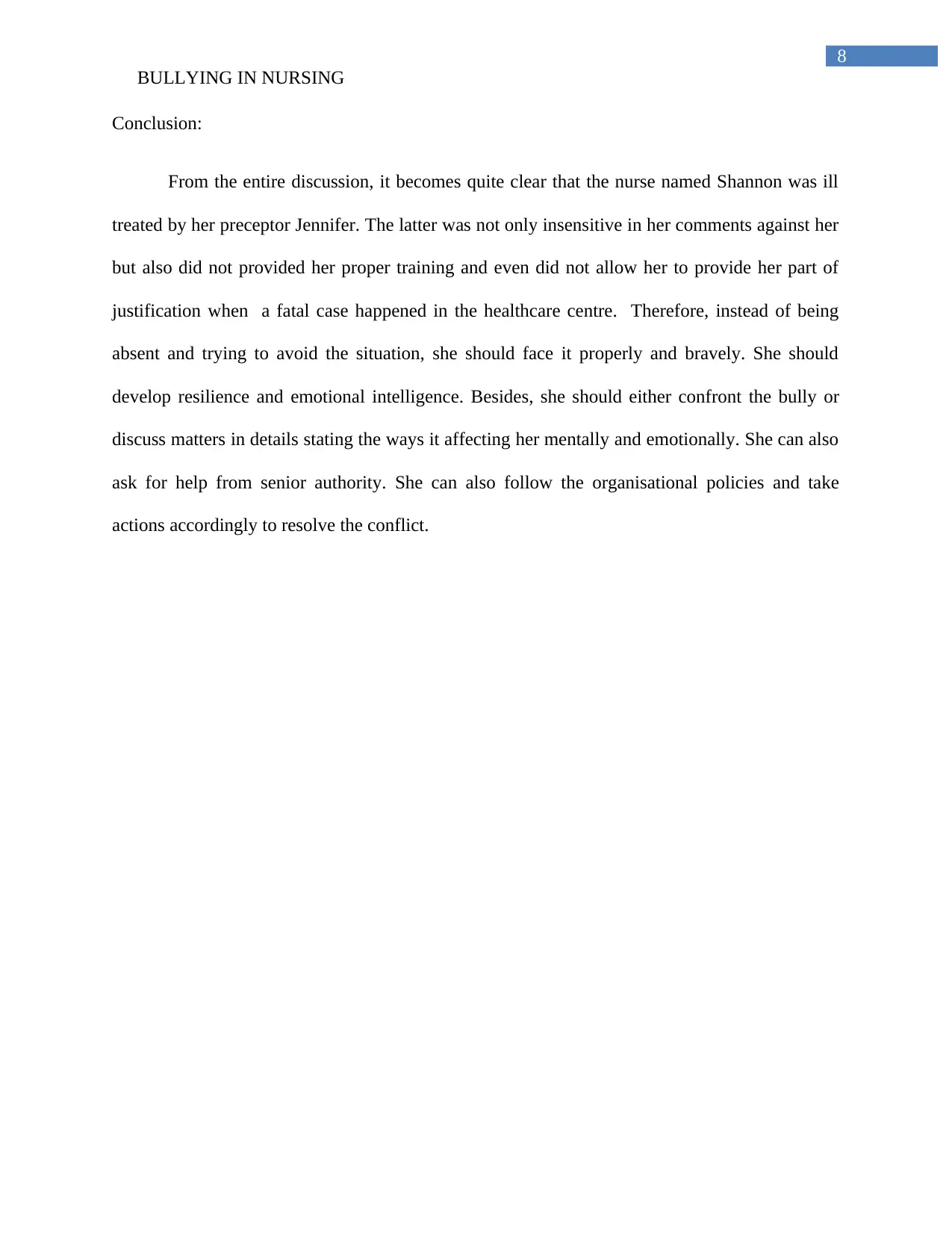
8
BULLYING IN NURSING
Conclusion:
From the entire discussion, it becomes quite clear that the nurse named Shannon was ill
treated by her preceptor Jennifer. The latter was not only insensitive in her comments against her
but also did not provided her proper training and even did not allow her to provide her part of
justification when a fatal case happened in the healthcare centre. Therefore, instead of being
absent and trying to avoid the situation, she should face it properly and bravely. She should
develop resilience and emotional intelligence. Besides, she should either confront the bully or
discuss matters in details stating the ways it affecting her mentally and emotionally. She can also
ask for help from senior authority. She can also follow the organisational policies and take
actions accordingly to resolve the conflict.
BULLYING IN NURSING
Conclusion:
From the entire discussion, it becomes quite clear that the nurse named Shannon was ill
treated by her preceptor Jennifer. The latter was not only insensitive in her comments against her
but also did not provided her proper training and even did not allow her to provide her part of
justification when a fatal case happened in the healthcare centre. Therefore, instead of being
absent and trying to avoid the situation, she should face it properly and bravely. She should
develop resilience and emotional intelligence. Besides, she should either confront the bully or
discuss matters in details stating the ways it affecting her mentally and emotionally. She can also
ask for help from senior authority. She can also follow the organisational policies and take
actions accordingly to resolve the conflict.

9
BULLYING IN NURSING
References:
AL‐Sagarat, A., Qan'ir, Y., AL‐Azzam, M., Obeidat, H., & Khalifeh, A. (2018, April). Assessing
the impact of workplace bullying on nursing competences among registered nurses in
Jordanian public hospitals. In Nursing forum. https://doi.org/10.1111/nuf.12253
Birks, M., Budden, L. M., Biedermann, N., Park, T., & Chapman, Y. (2017). A ‘rite of
passage?’: Bullying experiences of nursing students in Australia. Collegian.
https://doi.org/10.1016/j.colegn.2017.03.005
Birks, M., Budden, L. M., Stewart, L., & Chapman, Y. (2014). Turning the tables: The growth of
upward bullying in nursing academia. Journal of advanced nursing, 70(8), 1685-1687.
https://doi.org/10.1111/jan.12317
Budden, L. M., Birks, M., Cant, R., Bagley, T., & Park, T. (2017). Australian nursing students’
experience of bullying and/or harassment during clinical placement. Collegian, 24(2),
125-133. https://doi.org/10.1016/j.colegn.2015.11.004
Condon, B. B. (2015). Incivility as bullying in nursing education. Nursing science
quarterly, 28(1), 21-26. https://doi.org/10.1177/0894318414558617
El-Houfey, A. A., El-Maged, N. S. A., Elserogy, Y. M., & El Ansari, W. (2015). Workplace
bullying against medical and nursing team working at emergency departments in Assiut
University Hospital. IOSR Journal of Nursing and Health Science, 4(2), 1-9.retreived
from:
https://www.researchgate.net/profile/Amira_El-Houfey/publication/275968216_Workpla
BULLYING IN NURSING
References:
AL‐Sagarat, A., Qan'ir, Y., AL‐Azzam, M., Obeidat, H., & Khalifeh, A. (2018, April). Assessing
the impact of workplace bullying on nursing competences among registered nurses in
Jordanian public hospitals. In Nursing forum. https://doi.org/10.1111/nuf.12253
Birks, M., Budden, L. M., Biedermann, N., Park, T., & Chapman, Y. (2017). A ‘rite of
passage?’: Bullying experiences of nursing students in Australia. Collegian.
https://doi.org/10.1016/j.colegn.2017.03.005
Birks, M., Budden, L. M., Stewart, L., & Chapman, Y. (2014). Turning the tables: The growth of
upward bullying in nursing academia. Journal of advanced nursing, 70(8), 1685-1687.
https://doi.org/10.1111/jan.12317
Budden, L. M., Birks, M., Cant, R., Bagley, T., & Park, T. (2017). Australian nursing students’
experience of bullying and/or harassment during clinical placement. Collegian, 24(2),
125-133. https://doi.org/10.1016/j.colegn.2015.11.004
Condon, B. B. (2015). Incivility as bullying in nursing education. Nursing science
quarterly, 28(1), 21-26. https://doi.org/10.1177/0894318414558617
El-Houfey, A. A., El-Maged, N. S. A., Elserogy, Y. M., & El Ansari, W. (2015). Workplace
bullying against medical and nursing team working at emergency departments in Assiut
University Hospital. IOSR Journal of Nursing and Health Science, 4(2), 1-9.retreived
from:
https://www.researchgate.net/profile/Amira_El-Houfey/publication/275968216_Workpla
Secure Best Marks with AI Grader
Need help grading? Try our AI Grader for instant feedback on your assignments.
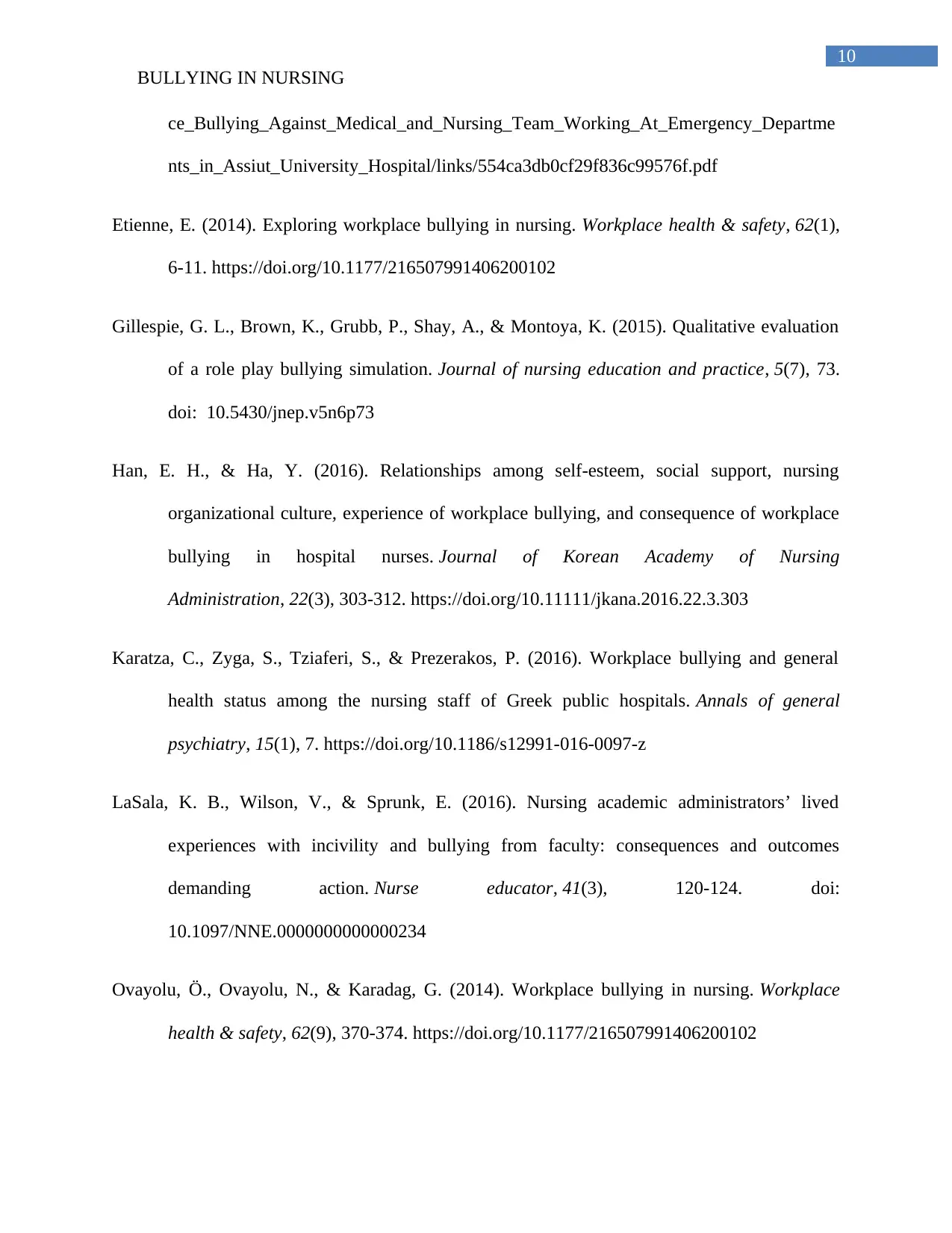
10
BULLYING IN NURSING
ce_Bullying_Against_Medical_and_Nursing_Team_Working_At_Emergency_Departme
nts_in_Assiut_University_Hospital/links/554ca3db0cf29f836c99576f.pdf
Etienne, E. (2014). Exploring workplace bullying in nursing. Workplace health & safety, 62(1),
6-11. https://doi.org/10.1177/216507991406200102
Gillespie, G. L., Brown, K., Grubb, P., Shay, A., & Montoya, K. (2015). Qualitative evaluation
of a role play bullying simulation. Journal of nursing education and practice, 5(7), 73.
doi: 10.5430/jnep.v5n6p73
Han, E. H., & Ha, Y. (2016). Relationships among self-esteem, social support, nursing
organizational culture, experience of workplace bullying, and consequence of workplace
bullying in hospital nurses. Journal of Korean Academy of Nursing
Administration, 22(3), 303-312. https://doi.org/10.11111/jkana.2016.22.3.303
Karatza, C., Zyga, S., Tziaferi, S., & Prezerakos, P. (2016). Workplace bullying and general
health status among the nursing staff of Greek public hospitals. Annals of general
psychiatry, 15(1), 7. https://doi.org/10.1186/s12991-016-0097-z
LaSala, K. B., Wilson, V., & Sprunk, E. (2016). Nursing academic administrators’ lived
experiences with incivility and bullying from faculty: consequences and outcomes
demanding action. Nurse educator, 41(3), 120-124. doi:
10.1097/NNE.0000000000000234
Ovayolu, Ö., Ovayolu, N., & Karadag, G. (2014). Workplace bullying in nursing. Workplace
health & safety, 62(9), 370-374. https://doi.org/10.1177/216507991406200102
BULLYING IN NURSING
ce_Bullying_Against_Medical_and_Nursing_Team_Working_At_Emergency_Departme
nts_in_Assiut_University_Hospital/links/554ca3db0cf29f836c99576f.pdf
Etienne, E. (2014). Exploring workplace bullying in nursing. Workplace health & safety, 62(1),
6-11. https://doi.org/10.1177/216507991406200102
Gillespie, G. L., Brown, K., Grubb, P., Shay, A., & Montoya, K. (2015). Qualitative evaluation
of a role play bullying simulation. Journal of nursing education and practice, 5(7), 73.
doi: 10.5430/jnep.v5n6p73
Han, E. H., & Ha, Y. (2016). Relationships among self-esteem, social support, nursing
organizational culture, experience of workplace bullying, and consequence of workplace
bullying in hospital nurses. Journal of Korean Academy of Nursing
Administration, 22(3), 303-312. https://doi.org/10.11111/jkana.2016.22.3.303
Karatza, C., Zyga, S., Tziaferi, S., & Prezerakos, P. (2016). Workplace bullying and general
health status among the nursing staff of Greek public hospitals. Annals of general
psychiatry, 15(1), 7. https://doi.org/10.1186/s12991-016-0097-z
LaSala, K. B., Wilson, V., & Sprunk, E. (2016). Nursing academic administrators’ lived
experiences with incivility and bullying from faculty: consequences and outcomes
demanding action. Nurse educator, 41(3), 120-124. doi:
10.1097/NNE.0000000000000234
Ovayolu, Ö., Ovayolu, N., & Karadag, G. (2014). Workplace bullying in nursing. Workplace
health & safety, 62(9), 370-374. https://doi.org/10.1177/216507991406200102
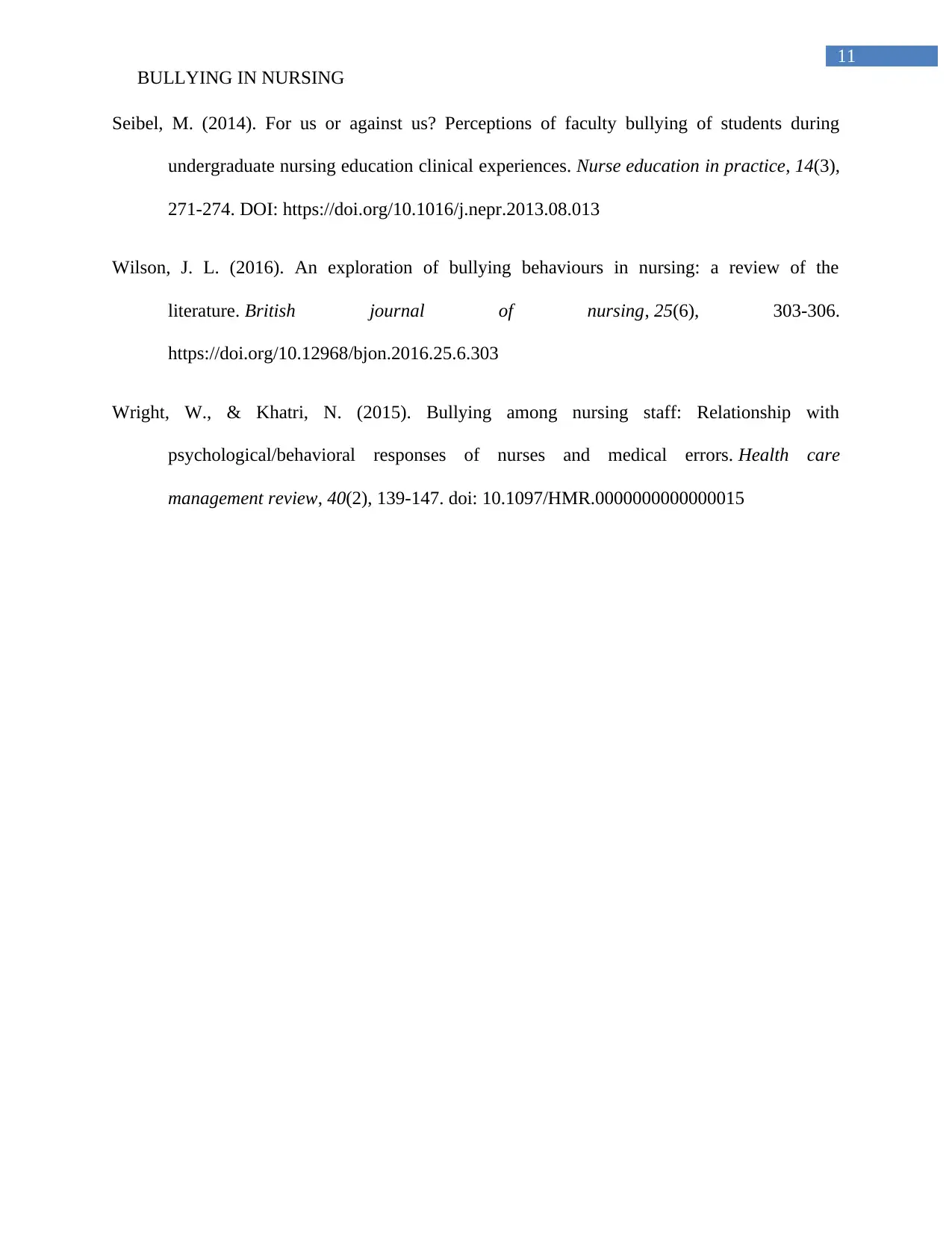
11
BULLYING IN NURSING
Seibel, M. (2014). For us or against us? Perceptions of faculty bullying of students during
undergraduate nursing education clinical experiences. Nurse education in practice, 14(3),
271-274. DOI: https://doi.org/10.1016/j.nepr.2013.08.013
Wilson, J. L. (2016). An exploration of bullying behaviours in nursing: a review of the
literature. British journal of nursing, 25(6), 303-306.
https://doi.org/10.12968/bjon.2016.25.6.303
Wright, W., & Khatri, N. (2015). Bullying among nursing staff: Relationship with
psychological/behavioral responses of nurses and medical errors. Health care
management review, 40(2), 139-147. doi: 10.1097/HMR.0000000000000015
BULLYING IN NURSING
Seibel, M. (2014). For us or against us? Perceptions of faculty bullying of students during
undergraduate nursing education clinical experiences. Nurse education in practice, 14(3),
271-274. DOI: https://doi.org/10.1016/j.nepr.2013.08.013
Wilson, J. L. (2016). An exploration of bullying behaviours in nursing: a review of the
literature. British journal of nursing, 25(6), 303-306.
https://doi.org/10.12968/bjon.2016.25.6.303
Wright, W., & Khatri, N. (2015). Bullying among nursing staff: Relationship with
psychological/behavioral responses of nurses and medical errors. Health care
management review, 40(2), 139-147. doi: 10.1097/HMR.0000000000000015
1 out of 12
Related Documents
Your All-in-One AI-Powered Toolkit for Academic Success.
+13062052269
info@desklib.com
Available 24*7 on WhatsApp / Email
![[object Object]](/_next/static/media/star-bottom.7253800d.svg)
Unlock your academic potential
© 2024 | Zucol Services PVT LTD | All rights reserved.





